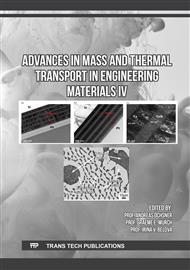p.13
p.33
p.45
p.71
p.81
p.93
p.107
p.117
p.127
CFD Analysis of Perforated Plates and Open-Cell Materials Aerodynamics
Abstract:
In this paper, a numerical study of fluid flow through perforated panels with square holes and open-cell material with cubic cells is presented. Structures with a wide variety of porosities (0.15<φ<0.94) and Reynolds numbers (0.01<Re<6000) are studied. Among the various outcomes obtained, the results indicate that pressure gradient vs Reynolds number exhibits three different forms of variation, including linear (Re<1), nonlinear (1≤Re<4000), and one where the pressure gradient is virtually constant with the Reynolds number (Re≥4000). The results were provided in terms of loss factor, but also of intrinsic permeability and the Forchheimer coefficient. Relationships that connect porosity to the loss factor, intrinsic permeability, and Forchheimer coefficient are also presented. These findings may prove useful in better understanding the flow behaviors in perforated panels and cell metal foams, which have a wide range of applications.
Info:
Periodical:
Pages:
81-90
Citation:
Online since:
December 2023
Authors:
Price:
Сopyright:
© 2023 Trans Tech Publications Ltd. All Rights Reserved
Share:
Citation:


